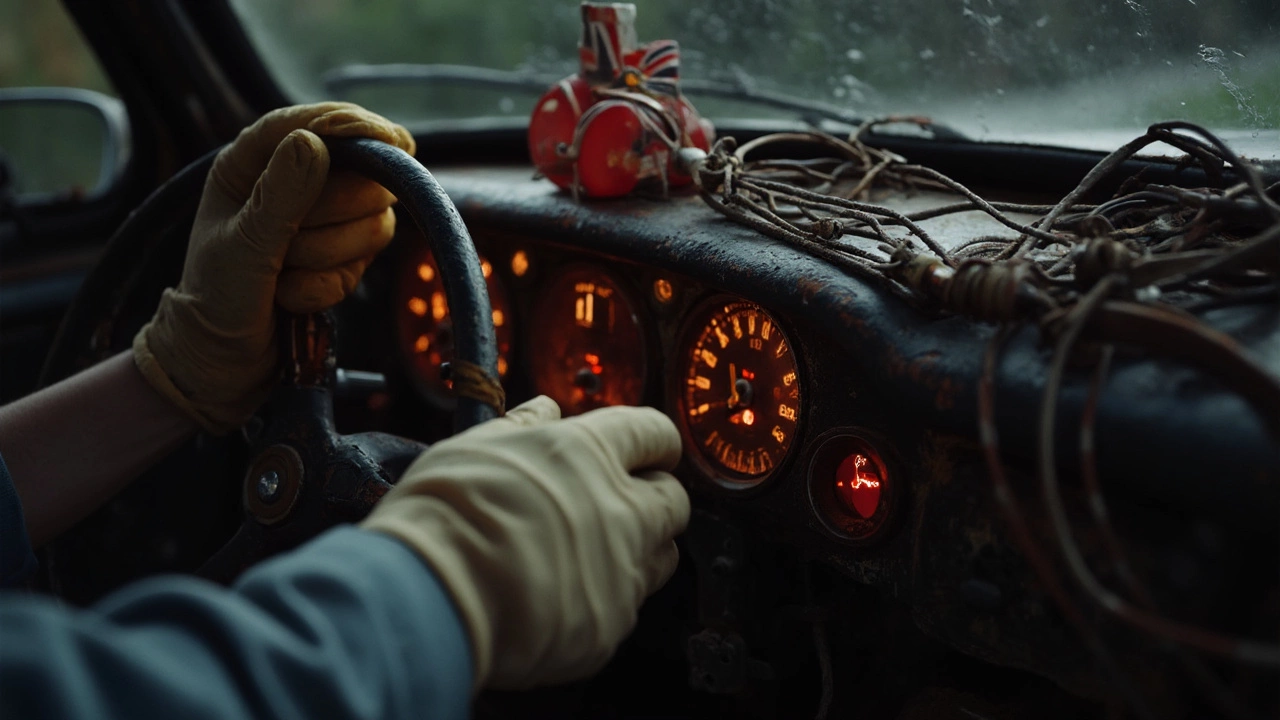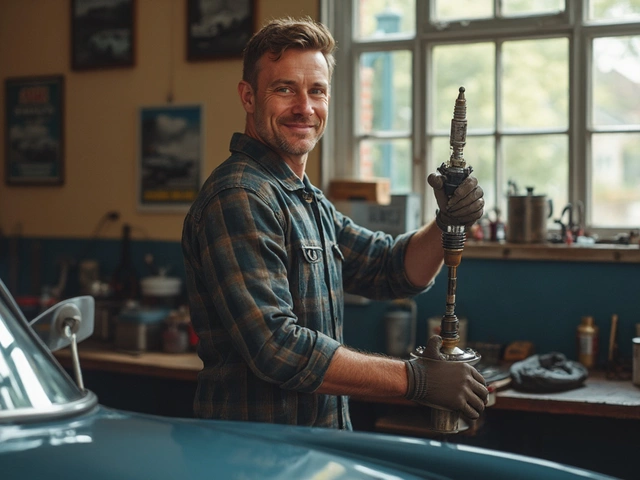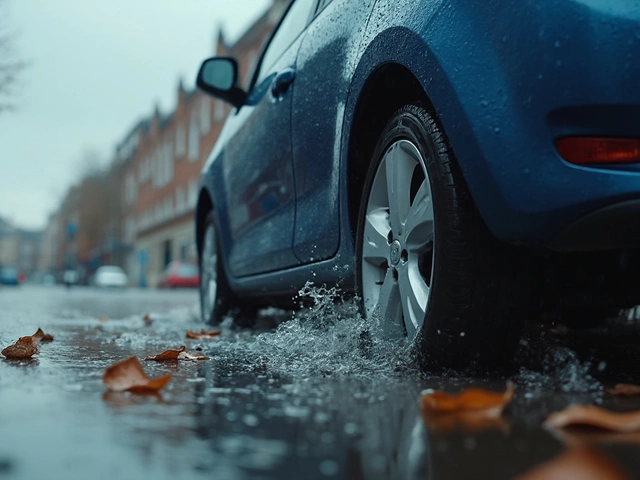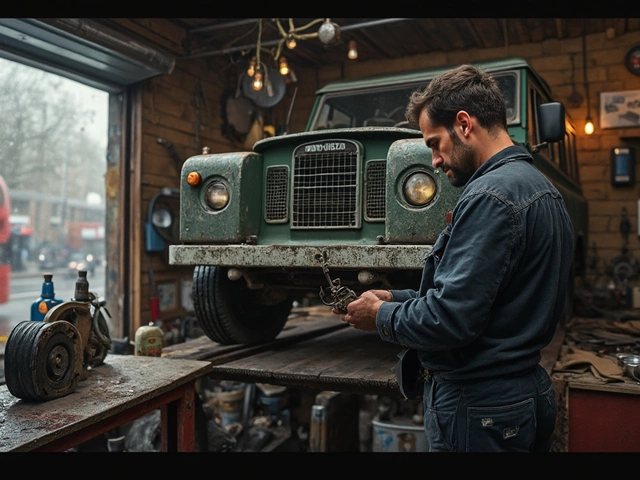Your car sputters, refuses to start, and you know something’s off. Most people panic when their fuel pump calls it quits, but you actually have a few tricks up your sleeve—if you know what to do. Ever heard of a guy smacking his gas tank with a rubber mallet to get his truck home? That’s not just a myth. It works because sometimes, a stuck fuel pump motor can get going again with a little nudge.
But before you even grab a tool, you need to be certain it’s the fuel pump that’s giving you grief. If your engine cranks but doesn’t start, you don’t hear the usual buzz from the gas tank when you turn the key, or your car just dies in the middle of driving, you might be dealing with a tired pump. The classic DIY fixes won’t solve every problem, but when you’re stranded on the side of the road, they might get you back to civilization—at least for a little while.
- How to Tell If Your Fuel Pump Is Failing
- Grab What You Need: Basic Tools and Materials
- The Classic 'Bang on the Tank' Trick
- Jumping the Relay or Fuse
- Letting the Pump Cool Down
- Why Temporary Fixes Aren't Enough (and What to Do Next)
How to Tell If Your Fuel Pump Is Failing
The annoying thing about a failing fuel pump is that it rarely quits all at once. Usually, it leaves some pretty clear signs if you know what to watch for. Ignoring those warning shots can leave you stranded, so here’s what to keep an eye (and ear) out for.
- Your engine cranks but just won’t start. If you’re sure there’s gas in the tank and the battery’s fine, but the car still won’t catch, the fuel pump could be the problem.
- You used to hear a faint buzz from the rear end when you turned the key. If that noise is gone now, your pump might not be priming at all.
- The car suddenly stalls or hesitates when you’re driving—especially if it happens over and over, at high speeds, or on hills.
- Poor acceleration or random jerks while driving. Sometimes the engine acts starved for power because it is: the fuel pump isn’t moving enough gas.
- Hard starts in the morning or after the car sits for a bit. If it eventually starts after several tries, that’s another classic symptom.
If you want hard evidence, there’s a simple test that most shops do: a fuel pressure check. This tells you if your pump is delivering enough pressure to make the engine run right. Not sure what numbers you should see? Here’s a quick table that shows typical psi (pounds per square inch) ranges for different types of fuel systems:
| Vehicle Type | Typical Fuel Pressure (psi) |
|---|---|
| Older Carbureted Engines | 4-7 |
| Modern Fuel Injected | 35-60 |
If your numbers are lower than what’s in the table, you’ve probably nailed down your issue—a weak or dead fuel pump. One last thing: Don’t forget about the fuel filter. A clogged filter can cause the exact same symptoms, so if in doubt, check both. But if the filter is new and things still aren’t right, the fuel pump is the likely culprit here.
Grab What You Need: Basic Tools and Materials
Before you start tinkering with a stubborn fuel pump, it pays to have the right stuff on hand. You're not doing any fancy repairs here—just a quick fix to get you moving. Here’s what most people rely on when dealing with this kind of trouble:
- Rubber mallet or a block of wood (for the classic 'tap the tank' trick)
- Flathead screwdriver
- Fuse puller or needle nose pliers
- Basic socket set (in case you need to remove a fuel pump relay or panel)
- Multimeter (for testing electrical connections if you suspect a fuse or relay issue)
- Protective gloves and safety glasses (because gas and skin don’t mix)
- A friend to help with cranking the engine or just for moral support
Depending on your situation, some fixes require almost nothing—smacking the tank only needs a rubber mallet (or whatever's handy, like the heel of your fist, honestly). Others, like checking the fuel pump relay, mean you’ll want basic tools ready so you’re not scrambling at the worst moment. According to Mike Allen, a well-known auto mechanic and columnist,
"Temporary roadside fixes for a failing fuel pump don’t call for much—usually just a few hand tools, some patience, and a knack for figuring out the problem."
You can stash most of these tools in an emergency kit in your trunk without taking up much space. It’s way better to be over-prepared than calling an expensive tow when a simple tap or relay check could do the trick.
The Classic 'Bang on the Tank' Trick
This fix isn’t just an old-school garage legend—you’ll still catch experienced mechanics giving the gas tank a good thump when a fuel pump stops working. Here’s the deal: electric fuel pumps can get stuck due to worn-out internal brushes or debris. A sharp knock can jolt things inside the pump, freeing it up just enough to start sending fuel again. It’s a patch, not a fix, but when you need to get moving, it’s worth a shot.
Most car fuel pumps are mounted inside the gas tank, so you’ll need to reach under the rear seat, or literally get under the car to access the lowest point on the tank. Don’t go swinging wildly—be careful and use something like a rubber mallet or even the palm of your hand. A hammer works, but stick a wood block between the hammer and the tank so you don’t dent or crack anything. If the tank is plastic, be extra gentle.
- Put the car in park and make sure the ignition is off.
- Locate the fuel tank (usually under or just behind the rear seat, or under the back end of the car).
- Give a few firm, controlled taps to the bottom or side of the tank.
- Try to start the engine. Listen for that fuel pump whine or buzz right as you turn the key.
- If the car starts, you’re likely dealing with a weak or sticking fuel pump motor—it’s time for a real repair soon!
Banging the tank works best on pumps with failing electric motors. This trick won’t help if the pump is completely dead or if the real issue is something else—like a blown fuse, clogged filter, or bad wiring.
| Vehicle Age | Success Rate (%) |
|---|---|
| 0-5 years | 10 |
| 6-10 years | 30 |
| 11-20 years | 55 |
This move is a last resort, not a morning routine. If your car fires up, head straight to a shop or somewhere safe. Sooner or later, that pump will stop responding to every trick you’ve got.

Jumping the Relay or Fuse
If the old "bang on the tank" trick gets you nowhere, you might have an issue with your fuel pump relay or fuse—not the pump itself. On many cars, especially models built after the 1990s, the fuel pump relay acts like a remote switch, sending power to the pump when you turn the key. If the relay or fuse goes bad, your fuel pump can't do its job, even if it's in great shape.
The right way to tackle this is to locate your fuse panel, usually under the dashboard or in the engine bay. Check your owner’s manual for the exact spot and the correct relay or fuse. Pop it out and inspect for anything burnt or broken. If the fuse is blown, swap it with a new one of the same rating. Easy win if that's all it is.
But let’s say the relay's gone bad or keeps clicking but no fuel is pumping. You can try "jumping" the relay. This basically means using a short piece of wire, sometimes called a jumper wire, to bridge two terminals where the relay plugs in, sending power directly to the fuel pump—no relay involved. Here’s how most people do it in a pinch:
- Turn off the car and disconnect the battery, just to be safe.
- Pull the relay out gently. Check the diagram on the relay or fuse panel lid to spot the power and load terminals. Usually, they're labeled 30 and 87.
- Take a short, insulated wire and connect terminal 30 to terminal 87 right in the socket. You're sending power straight to the pump now.
- Reconnect the battery, try starting the car. If it runs, you've found the weak link.
Be careful: This is totally temporary. There’s a legit risk of overheating your wires or damaging the control circuit if left like this. Vehicles rely on relays to avoid overloads. As Car and Driver magazine puts it,
“Bypassing a safety device is only okay if you’re truly stuck and just need to get out of a tough spot.”If you go this route, aim to drive straight to a mechanic.
This jump-wire move is a classic trick, especially among roadside rescue crews, but never trust it for daily driving. Always swap the faulty relay or fuse as soon as you can.
Letting the Pump Cool Down
Believe it or not, sometimes a dodgy fuel pump just needs a break. When a pump is running hot—especially if you’ve been driving in stop-and-go traffic or it’s a scorching day outside—it can overheat and stall out. Older vehicles or high-mileage pumps are extra prone to this because the internal parts wear down and heat up much faster than normal.
If you’re stuck, try letting your car sit with the ignition off for 15-30 minutes. This downtime lets the pump cool and might help it reset itself enough to give you one more start. Folks have limped their cars back home or at least to a safer place just by waiting it out. Here’s a simple step-by-step to get the timing right:
- Turn off the ignition fully. Don’t leave it in accessory mode either—give it a complete break.
- Pop the hood. Heat escapes faster this way, especially on hot days.
- Grab a drink or make a quick call—set a timer if you need. Give the car at least 15 minutes, longer if you’ve got time and can wait it out safely.
- Try to start the engine again. Listen for that faint whir from the gas tank as you turn the key. If you hear it, there’s a shot your pump has come back to life, at least for a short trip.
Most modern pumps are cooled by the fuel flowing over them, so running low on gas can actually make them overheat faster. If you get the engine running after the cool-down, swing by a gas station and top off the tank. A good rule: don’t let it drop below a quarter tank if your pump has started acting up.
If you’re wondering just how common heat-related fuel pump trouble is, take a look at these quick stats:
| Cause | Percentage of Fuel Pump Failures |
|---|---|
| Heat Overload | 25% |
| Electrical issues | 30% |
| Clogged Filters | 20% |
| Low Fuel Running | 15% |
| Other | 10% |
This isn’t a permanent fix, but buying yourself an extra few miles to a mechanic or a safe spot can make all the difference. And always use caution—never try this if you’re blocking traffic or stranded somewhere unsafe. It’s just a quick trick to avoid paying for a tow, not a way to dodge fixing the real problem.
Why Temporary Fixes Aren't Enough (and What to Do Next)
Temporary fixes for a busted fuel pump can save your day, but they’re not real solutions. Smacking the gas tank might get your car started, but the inside of the pump is still wearing out. Fuel pumps don’t just get better on their own; they either work, or they don’t. Some folks try bypassing the relay or cooling down the pump, but these are just stopgaps—meant to get you off the side of the road, not to keep you driving for weeks.
Driving around with a failing fuel pump risks bigger problems. A weak pump doesn’t send enough gas to the engine, so you’ll get poor acceleration, rough idling, or the car might stall in traffic. In worst-case scenarios, a dying pump can overheat and even damage other parts of your fuel system. That spells a much higher repair bill down the line.
Once you get your car started with a quick trick, get it to a mechanic or your driveway as soon as possible. Here’s what you should do next:
- Schedule a professional diagnosis if you’re not 100% sure the pump’s the problem—mechanics have the tools to check fuel pressure and electrical flow.
- If you’re a DIYer, look up your exact vehicle’s service manual before replacing the pump, since methods differ on every make and model.
- Never ignore recurring symptoms like sputtering, no-starts, or stalling. They don’t go away by themselves. Every time this happens, your risk of being stranded goes up.
One more tip: before replacing anything, check your fuel filter. A clogged filter can mimic all the same issues and is a way cheaper fix. But if you’re certain it’s the pump, don’t wait—get it replaced. A quality fuel pump can last over 100,000 miles, so if you do it right, you shouldn’t have to deal with this again soon.






